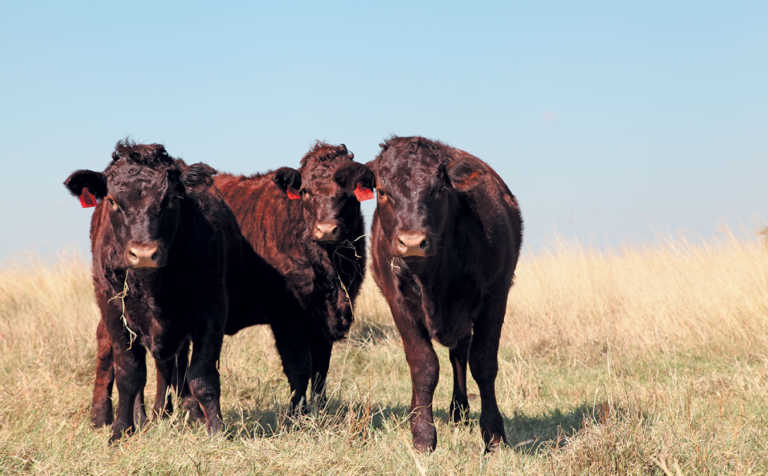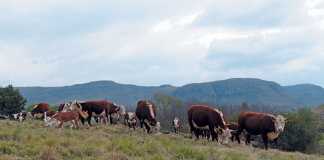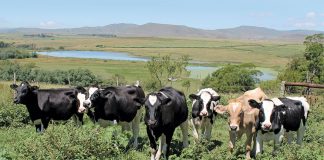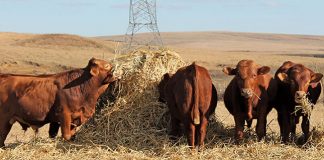
Photo: Gerhard Uys
The commercial Sussex herd on the farm, Skietlaagte, near Viljoenkroon in the Free State, maintains a 95% conception rate in both wet and dry years. So says Dallas Phillips, who has managed the herd for four decades.
The herd forms part of the Rhys Evans Group.
The herd has been free of brucellosis (contagious abortion) since its inception, and bull calves are weaned at seven months at between 285kg and 295kg, and heifers at about 265kg.
Health and fertility
To achieve these excellent results, certain basic management principles must be in place, says Dallas.
“The most important thing in any beef breeding enterprise is fertility. If one expects high reproduction rates, herd health has to be outstanding.”
The Skietlaagte herd is inoculated annually against all relevant diseases, such as congenital contractural arachnodactyly (CA), trichomonas and vibriosis, with sheath washing done on all bulls as well.
Good herd health is further promoted by having a single breeding season, which simplifies management. Having two breeding seasons makes the management of herd health and inoculations difficult, as groups are at different stages of production and need to be treated differently, Dallas explains.
Heifers are mated six weeks before the cows at 23 months of age and mating takes place over a six-week period. The heifers’ calving has therefore been concluded by the time the cows start to calve.
This is important, as heifers usually have a higher incidence of birthing difficulties. Cows are mated for three months from November to January, he explains.
Dallas says that mating cows earlier would be problematic in that area. Calving in April or May, for example, would coincide with sub-optimal grazing, resulting in calving difficulties, and consequently a lower reconception rate.
He tried introducing an earlier calving season in the past, as there is maize stover available on the farm to use as supplementary feed, but it was unsuccessful.
“Irrespective of stover, those calves never grow out [properly] and wean at a weight of about 230kg. You lose 55kg at weaning, which is a lot of money. We mate cows between November and January and [they then] calve between August and October. In this way, the calves are born before spring and start grazing as the pastures reach their peak,” he says.
Dallas’ culling criteria are extremely rigorous. When a cow is mated, she has to have a calf at foot, proof that she gave birth and raised the calf. If there is no calf at foot, she is culled.
Fodder flow
As part of his management system, Dallas has a comprehensive fodder flow programme and grazing strategy.
On Skietlaagte, cows generally have a calf at foot during September and October before the start of spring rain. Dallas stresses that the pressure is on to get the animals through this period without costs going sky-high.
He uses a four-camp system, with the idea being to rest one of the four camps for an entire growing season. The other three camps are then grazed on a rotational basis throughout the growing season, and the cattle are moved as soon as they have grazed almost all the grass in a particular camp.
Grazing on Skietlaagte consists primarily of red grass (Themeda triandra) and Smutsfinger grass (Digitaria eriantha).
During ‘wet’ years, Dallas tries to rest two camps for the period between the first rainfall and the first frost. During seasons when fodder flow is a problem, cattle graze the camps that have been rested, usually between August and September.
Taking stover into account, Dallas aims to maintain a stocking density of 3,5LSU/ha to 4LSU/ha.
In addition to pasture and veld, hay and silage made on the farm is used to supplement grazing. Eragrostis teff is planted for cutting and baling.
Dallas prefers silage, as it is cheaper than hay when measured per ton of dry matter. The quantity of silage produced depends on the grazing in a particular season.
If grazing is plentiful, less silage is needed, so he does not make additional silage and relies solely on reserves. Silage is simply used as standby during unforeseen ‘El Niño-type drought periods’, he explains.
Dallas believes in keeping lick expenses to a minimum, but without cutting corners. This is achieved by providing the correct lick at the right time, he says.
In summer, the cattle receive a mineral phosphate lick. In winter, non-producing cows receive a protein lick and those in production, a production lick.
Cows with calves are kept in groups of 35 where they remain until calves are weaned. “It’s important to ensure that lick intake is correct,” says Dallas.
He closely follows packaging instructions, and monitors cattle to ensure that they do not consume more than the prescribed amount, “otherwise they’ll bankrupt you”.
Herd management
Keeping groups of cows of the same age or production stage together is important.
“We keep weaners, yearlings, open heifers, in-calf heifers, first-calvers and cows separate. Once a first-calver raises her first calf she’s moved into the cow group,” Dallas explains.
By separating cows in this way, he develops a better ‘feel’ for a group. “As soon as groups are mixed, you cannot [properly] assess a situation, or see whether there’s a health or growth problem in the group.”
All heifers are considered to be replacement animals, while all bull calves are castrated and sent to the Huntersvlei feedlot after weaning.
Pregnancy tests are conducted annually on the herd and the 4% of cows that do not conceive yearly, as well as the 2% whose calves may have died, are culled.
“I don’t want cows [in the herd] that are older than 10 or 11 years of age. Many farmers emphasise longevity, but I like to focus on genetics. The longer you keep a cow in the herd, the more difficult you make it for young cows and new genetics to enter the herd. Two-year-old heifers should be genetically better than 13-year-old cows,” Dallas says.
Excess animals that are not culled are sold at the Huntersvlei sale held in August every year.
Pure breeds
Dallas says there is a definite place for pure breeds in the commercial cattle sector. With crossbreeding, heterosis corrects many defects and the offspring of such cattle are mostly genetically superior to their dams and sires. But the results are evident for only a year.
Using pure breeds in a commercial herd facilitates accurate selection for desirable traits such as birth mass, milk production and weaning weight.
Dallas runs his commercial herd like a stud herd, with cows and calves weighed at birth, and 18-month weight for heifers considered during selection for inclusion in the herd. Birthweight and cow-to-calf weight ratios are also considered.
Keeping the cow-to-calf weight ratio below 7% ensures that cows do not experience calving difficulties.
He only uses stud bulls from the Huntersvlei Sussex stud, putting one bull to 35 cows and rotating them throughout the breeding season. This ensures that all cows are covered, should one of the bulls develop a problem that is not picked up by herdsmen during the breeding season.
“When selecting a bull, I look at birth mass, milk production and weaning weight, and I want a balance between them,” says Dallas.
“I also want a balance between EBVs and conformation. [But] one shouldn’t get carried away with EBVs. Focus on the economically important traits and select for them.”
He adds that a bull should have good legs and walk well. It should also have sound testes.
At the end of the breeding season, two or more cow groups may be combined if grazing allows.
But Dallas has found that smaller groups work better as there is less competition at watering points and troughs, while ill or injured animals can be identified more readily.
Phone Dallas Phillips on 084 588 9955, or email [email protected]. Visit re.co.za.













